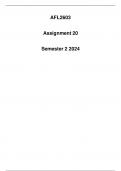AFL2603
Assignment 20
Semester 2 2024
, Question 1
1.1
Traditional Folksongs:
Historical Context: Traditional folksongs often reflect the historical and cultural
context of the time they were created, such as historical events, local legends,
or cultural practices.
Oral Tradition: These songs were primarily passed down orally from one
generation to the next, often without written notation.
Cultural Specificity: Traditional folksongs are deeply rooted in the specific
cultural practices, languages, and customs of particular communities.
Current Folksongs:
Modern Influences: Current folksongs may incorporate modern influences and
themes, such as contemporary social issues or global events.
Written Documentation: Many current folksongs are documented and
published, making them accessible to a wider audience.
Fusion and Adaptation: Current folksongs often blend traditional elements
with other genres or styles, reflecting a fusion of cultural influences.
1.2
Folksong Example: “Kumbaya” (a traditional American folk song).
Message: The song is often interpreted as a plea for unity and peace, with the
repeated refrain of “Kumbaya” meaning “Come By Here” in Gullah. It emphasizes the
desire for divine presence and community togetherness.
1.3
• Cultural Preservation: They help preserve and transmit cultural heritage and
traditions.
• Social Commentary: Folksongs can provide commentary on social issues or
historical events.
• Education: They can serve as educational tools, teaching values, history, and
customs.
• Entertainment: They provide entertainment and enjoyment for listeners and
performers.
• Community Bonding: Folksongs often play a role in bringing communities
together, especially during communal activities or celebrations.




